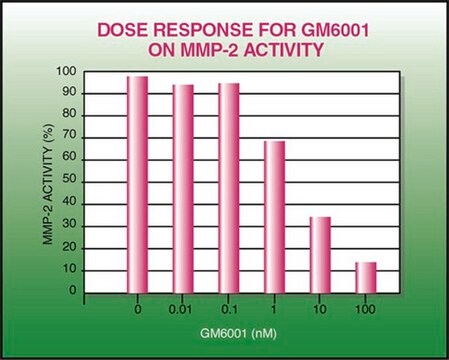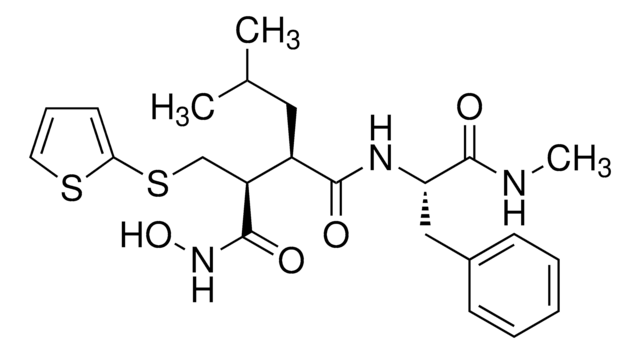PZ0198
Prinomastat hydrochloride
≥95% (HPLC)
Synonym(s):
(S)-2,2-Dimethyl-4-((p-(4-pyridyloxy)phenyl)sulfonyl)-3-thiomorpholinecarbohydroxamic acid hydrochloride, AG 3340 hydrochloride, AG-3340 hydrochloride, AG3340 hydrochloride
About This Item
Recommended Products
Assay
≥95% (HPLC)
form
powder
storage condition
desiccated
color
white to beige
solubility
H2O: 15 mg/mL (clear solution)
storage temp.
room temp
SMILES string
Cl.CC1(C)SCCN([C@H]1C(=O)NO)S(=O)(=O)c2ccc(Oc3ccncc3)cc2
InChI
1S/C18H21N3O5S2.ClH/c1-18(2)16(17(22)20-23)21(11-12-27-18)28(24,25)15-5-3-13(4-6-15)26-14-7-9-19-10-8-14;/h3-10,16,23H,11-12H2,1-2H3,(H,20,22);1H/t16-;/m0./s1
InChI key
UQGWXXLNXBRNBU-NTISSMGPSA-N
General description
Application
Biochem/physiol Actions
Signal Word
Danger
Hazard Statements
Precautionary Statements
Hazard Classifications
Repr. 1B
Storage Class Code
6.1C - Combustible acute toxic Cat.3 / toxic compounds or compounds which causing chronic effects
WGK
WGK 3
Flash Point(F)
Not applicable
Flash Point(C)
Not applicable
Regulatory Listings
Regulatory Listings are mainly provided for chemical products. Only limited information can be provided here for non-chemical products. No entry means none of the components are listed. It is the user’s obligation to ensure the safe and legal use of the product.
JAN Code
PZ0198-BULK:
PZ0198-VAR:
PZ0198-5MG:
PZ0198-25MG:
Certificates of Analysis (COA)
Search for Certificates of Analysis (COA) by entering the products Lot/Batch Number. Lot and Batch Numbers can be found on a product’s label following the words ‘Lot’ or ‘Batch’.
Already Own This Product?
Find documentation for the products that you have recently purchased in the Document Library.
Our team of scientists has experience in all areas of research including Life Science, Material Science, Chemical Synthesis, Chromatography, Analytical and many others.
Contact Technical Service








